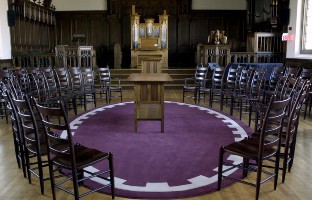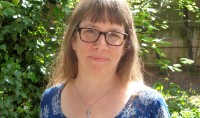Devotional difference

One of the things I love best about teaching in a divinity school is that there are many opportunities to worship. At least once, and sometimes two or three times a day, groups of students, staff and faculty gather to pray, meditate, share the Eucharist, chant and dance. Sometimes I'm among them—Thursday morning Eucharist is the gathering to which I'm most faithful. Usually I just get a quick peek at what's going on in the chapel as I move back and forth between meetings and classes. Catching a glimpse of another's devotion is a blessing on the day, a reminder of the love that undergirds our best work.
On Wednesdays at noon we gather for community worship organized by a student steering committee and the director of religious and spiritual life. When I first came to Harvard Divinity School, the weekly community worship service was deeply ecumenical. While the shape of the service was recognizably Protestant, it also possessed a flexibility born of a desire to create a welcoming, open space for people of different theological and religious backgrounds.
Read our latest issue or browse back issues.
Over the years, as our school has become more multireligious, our students have urged us toward new ways of gathering for community worship. Even the most welcoming service can obscure our distinctiveness, they told us. We want to be with each other as we truly are, they said. We want to be present for each other's prayers and rituals and practices. We want to be led in Torah study by the Jewish students and in Friday prayers by the Muslims; to listen to a dharma talk with the Buddhist students and hear a sermon with the Baptists; to be with the Episcopalian students for the Eucharist and with the Hindus for puja; to light Advent candles with the Roman Catholics, offer prayers at the flaming chalice with the Unitarian Universalists and keep silence with the Quakers.
These days our community worship is led by one of the religious communities in our school. We begin with brief opening words (our beloved Protestant forms persist!) and a lifting up of the prayers, hopes and longings collected in a notebook at the door of the chapel. Then we enter into the practice of a particular religious community, joining in where we can, maintaining a respectful presence where we feel we cannot. Each week, as the distinctiveness of each tradition becomes visible, we can see more clearly the differences between our ritual practices, our holy books, our music and our conceptions of the divine, and we see the family resemblances, the shared concerns—what Thomas Merton called the "wider oikoumene" of the human family.
The desire of students to be present to each other as distinctively religious people seems to me characteristic of this generation—or at least of this current crop of divinity students. While earlier generations sometimes muted explicit religious symbolism out of a desire to cross the boundaries of difference, this generation seems to be more convinced that it is from the specificity of our religious traditions that we will reach one another.
When a group of students calling themselves Protest Chaplains arrived in New York City on the first day of the Occupy Wall Street protest, they dressed in albs, carried a cardboard cross and welcomed conversation about why they felt called to be there. "We wanted to be visible as Christians," Dave Woessner explained, "so we wore white albs as a symbolic connection to our baptismal vocation and because we were experimenting with protesting economic injustice as a liturgical act." Journalists from all over the world interviewed them. "If you could articulate one demand, what would it be?" an interviewer asked Dave. "That we love our neighbors as ourselves," he replied.
What effect will the growing pluralism in theological schools have on the education of ministers and their formation in their traditions? If students from several traditions study for ministry together, will that smooth out the theological differences among them? Will our students be prepared to lead communities with distinctive religious identities? Several theological schools, mine included, have attempted to craft programs in which students from different religious traditions can prepare for religious leadership side by side.
As our students have insisted, smoothing out theological differences is not a goal of multireligious theological education. The goal is to be able to embody one's own religious commitment, narrative and practice in the midst of work shared with people of all faiths and none. All ministers need be able to bring—and to help others to bring—the distinctive wisdom of their traditions to bear on the most urgent questions of human life, and all ministers need to be able to work across boundaries to address those questions with others. We struggle to discover just the right curriculum for this. But certainly all of us are blessed when we catch a glimpse of each other's devotion and remember the wider oikoumene to which we are all called.







